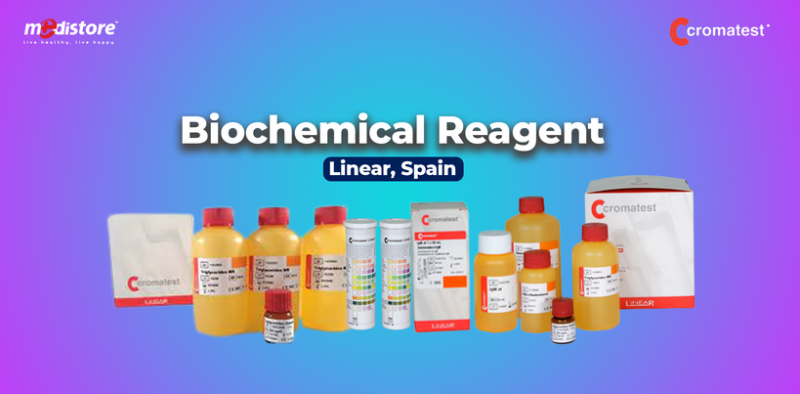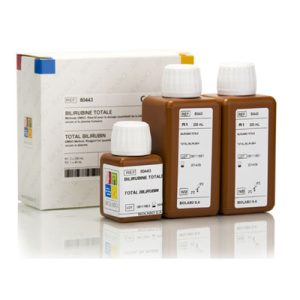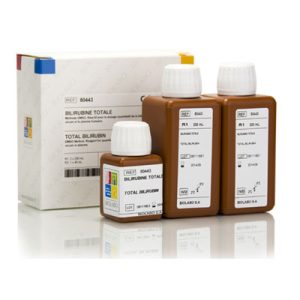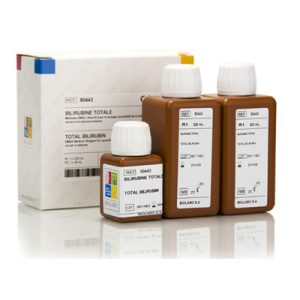Subtotal:
150.00৳
Urea Berthelot Biochemistry Reagent – 400Test
3,500.00৳ Original price was: 3,500.00৳ .3,280.00৳ Current price is: 3,280.00৳ .
Urea Berthelot Biochemistry Reagent
Packaging Size: 4x100ml
Origin: Spain
Brand : Cromatest / Linear
Packaging Type: Bottle
Test/Pack: 400Test
Method: Enzymetic colorimetric method
Categories Biochemistry Reagents, Lab Reagents
Tags Biochemistry Reagent, Lab reagent, Urea berthelot reagent, urea reagent

01405100400
Free Delivery
For order. over 15,000 Taka
7 Days Return
If products have problems
Secure Payment
100% secure online payment.
Dedicated Support
Dedicated online and offline support
Urea Berthelot Biochemistry Reagent
PRINCIPLE:
Urea is hydrolyzed by urease1,2 into ammonia and carbon dioxide. The ammonia generated reacts with alkaline hypochlorite and sodium salicylate in presence of sodium nitroprusside as coupling agent to yield a blue cromophore. The intensity of the color formed is proportional to the concentration of urea in the sample
REAGENT COMPOSITION:
R1 – Enzyme reagent. Urease > 500 U/mL. Stabilizers
R2 – Buffered chromogen. Phosphate buffer 20 mmol/L pH 6.9, EDTA 2 mmol/L, sodium salycilate 60 mmol/L, sodium nitroprusside 3.4 mmol/
R3: Alkaline hypochlorite. Sodium hypochlorite 10 mmol/L, NaOH 150 mmol/L
CAL – Urea standard. Urea 50 mg/dL (8.3 mmol/L) Organic matrix based primary standard
Working reagent. Mix 1 volume of R1 + 1 volume of R2. Stable for 1 week at room temperature, stored tightly closed and protected from light.
STORAGE AND STABILITY: Store at 2-8ºC.
The reagents are stable until the expiry date stated on the label.
REAGENT PREPARATION:
Working reagent. Mix 1 volume of R1 + 24 volumes of R2. Stable for 4 weeks at 2-8ºC and for 7 days at 15-25ºC.
Discard the reagent if the blank presents an absorbance above
0.120 at 600 nm against distilled water or if it fails to recover the declared values of control sera.
SAMPLES:
Serum or heparinized plasma free of hemolysis and urine (see Notes). Other anticoagulants (ammonium heparinate or double oxalate of potassium and ammonium ) must not be used.
Urea in serum, plasma or urine is stable 7 days at 2-8ºC. Freeze
Samples with concentrations higher than 300 mg/dL (50 mmol/L) should be diluted 1:5 with saline and assayed again. Multiply the results by 5.
Urine
Dilute the sample 1:50 with distilled water and multiply the result by 50.
If results are to be expressed as SI units apply: mg/dL x 0.1665 = mmol/L
To convert urea mass units to those of urea nitrogen apply: mg/dL x 0.467 = mg/dL BUN
INTERFERENCES:
- Contamination of glassware and water by ammonia, will give falsely elevated results.
- Bilirubin (< 20 mg/dL) and triglycerides (< 10 g/L), do not Hemoglobin ( > 5 g/L) interfere.3
- Fluorides used commonly as anticoagulants inhibit the urease of the 4
MATERIALS REQUIRED:
Photometer or colorimeter capable of measuring absorbances at 600 ± 10 nm.
- Constant temperature incubator set at 37ºC.
- Cuvettes with 1-cm
- Pipettes to measure reagent and

PROCEDURE:
- Bring reagents and samples to room
- Pipette into a cuvette:
TUBES Blank Sample Standard Working reagent 1.0 mL 1.0 mL 1.0 mL Sample – 10 mL – Standard – – 10 mL
3.Mix and incubate for 5 minutes at 37ºC or for 10 minutes at room temperature (16-25ºC)
4.Pipette:
| R3 | 1.0 mL | 1.0 mL | 1.0 mL |
5. Mix thoroughly and incubate the tubes for 5 minutes at 37ºC or for 10 minutes at room temperature (16-25ºC).
6. Read the absorbance (A) of the samples and the standard at 600 nm against the reagent blank.
The color is stable for at least 2 hours protected from light.
REFERENCE VALUES:
Serum, plasma:
| Newborns (< 10 days) | 6.4-53.5 mg/dL (1.1-9.0 mmol/L) |
| Adults (12-60 years) | 15-40 mg/dL (2.5-6.6 mmol/L) |
In adults over 60 years of age, the reference interval is 17-50 mg/dL (2.8-8.3 mmol/L) and the concentrations tend to be slightly higher in males than in females
Urine:
Adults (normal diet): 26-43 g/24-h (428-714 mmol/24-h)
A high-protein diet causes significant increases in plasma urea concentrations and urinary excretion.
It is recommended that each laboratory establishes its own reference range.
QUALITY CONTROL:
The use of a standard to calculate results allows to obtain an accuracy independent of the system or instrument used.
To ensure adequate quality control (QC), each run should include a set of controls (normal and abnormal) with assayed values handled as unknowns.
Buy Hematology Analyzer Reagent ar best price from Medistore
CLINICAL SIGNIFICANCE:
Urea is the chief end product of protein metabolism in the body. The importance of the urea concentration in blood lies in its value as an indicator of kidney function.
Azotemia ( an abnormal increase in plasma urea level) is seen mainly in renal disorders, dehydration, increase protein catabolism, high-protein diets, or gastrointestinal hemorrhage. There are two types of azotemia. The first, prerenal azotemia, is caused by impaired perfusion of the Kidneys due to decreased cardiac output or for any of the former causes. The second, postrenal azotemia, is caused by an obstruction in the urine outflow such as nephrolithiasis, prostatism, and tumors of the genitourinary tract.
The clinical significance of the urea level in plasma is usually determined in conjugation with the plasma creatinine level. In prerenal azotemia, an increase in the plasma urea level is usually associated with a normal plasma creatinine level, where as in postrenal azotemia, there is an increase in both the urea and the plasma creatinine levels. A decrease in the urea plasma level may be associated with acute dehydration, malnutrition, and pregnancy.
NOTES:
- Collect a 24-hour urine specimen into a plastic bottle free of Keep the sample refrigerated to minimize urea hydrolysis by microorganisms or other agents.
ANALYTICAL PERFORMANCE:
- LInearity:Up to 300mg/dL
- Precision
mg/dL Within-run Between-run Mean 25.7 60.1 130 25.7 60.1 130 SD 0.23 0.8 1.65 1.01 1.36 2.3 CV% 0.89 1.33 1.27 3.9 2.26 1.77 N 10 10 10 10 10 10 - Replicates: 10 for each level. Replicates: 10 for each level Instrument: UVIKON 930 for 8 days.
- Sensitivity. Using a 1:100 sample/reagent at 600 nm, 1 mg of urea will produce a net absorbance of approximately 002.
- Correlation. This assay (y) was compared with a similar commercial method (x). The results were:
N = 25 r = 0.999 y = 0.976x – 1.06
-
REFERENCES:
- Chaney, A.L., and Marbach, P. Clin. Chem. 8 : 132 (1962).
- Searcy, L., Reardon, J.E., and Foreman, J.A. Am. J. Clin. Technol. 33 : 15-20 (1967).
- Young, S. Effects of Drugs on Clinical Laboratory Tests. 4 th Edition. AACC Press (1995).
- Patton, S., and Crouch, S.R. Anal. Chem. 49 : 464 (1977).
- N.W. Clinical Guide to Laboratory Tests, 3rd Edition.
Best Quality Diagnostic Products Buy from Medistore
Brand
Chromatest
Linear
Be the first to review “Urea Berthelot Biochemistry Reagent – 400Test” Cancel reply
Related Products
Related products
-
Biochemistry Reagents
AMS CK-NAK
Rated 0 out of 56,000.00৳Original price was: 6,000.00৳ .5,500.00৳ Current price is: 5,500.00৳ . Add to cart -
Biochemistry Reagents
Ams Triglyceride
Rated 0 out of 53,500.00৳Original price was: 3,500.00৳ .3,000.00৳ Current price is: 3,000.00৳ . Add to cart -
Biochemistry Reagents
AMS LDH
Rated 0 out of 57,000.00৳Original price was: 7,000.00৳ .6,000.00৳ Current price is: 6,000.00৳ . Add to cart -
Biochemistry Reagents
AMS Hemoglobin
Rated 0 out of 51,500.00৳Original price was: 1,500.00৳ .1,200.00৳ Current price is: 1,200.00৳ . Add to cart
Our Best Selling Products
-
Mesh Nebulizer
Mesh Nebulizer – Portable Ultrasonic Inhaler Mesh Nebulizer
Rated 0 out of 52,750.00৳Original price was: 2,750.00৳ .1,800.00৳ Current price is: 1,800.00৳ . Add to cart -
Mesh Nebulizer
Mesh Nebulizer JSL-W301 – Portable Ultrasonic Inhaler Mesh Nebulizer
Rated 0 out of 52,500.00৳Original price was: 2,500.00৳ .1,500.00৳ Current price is: 1,500.00৳ . Add to cart -
Biochemistry Analyzer
Mindray BA-88A Semi-Auto Chemistry Analyzer
Rated 0 out of 5180,000.00৳Original price was: 180,000.00৳ .150,000.00৳ Current price is: 150,000.00৳ . Add to cart -
CLIA System
AutoLumo A1860 – Automatic Chemiluminescence Immunoassay System
Rated 0 out of 51,800,000.00৳Original price was: 1,800,000.00৳ .1,600,000.00৳ Current price is: 1,600,000.00৳ . Add to cart -
Microscope/Binocular
Cypress CM001 Cyanscope Microscope
Rated 0 out of 5140,000.00৳Original price was: 140,000.00৳ .110,000.00৳ Current price is: 110,000.00৳ . Add to cart -
Ultrasound Machine
Mindray DC-N3 Pro Ultrasound Machine
Rated 0 out of 51,350,000.00৳Original price was: 1,350,000.00৳ .1,150,000.00৳ Current price is: 1,150,000.00৳ . Add to cart -
Serology Reagent
S.Paratyphi-BH Antigen Serology Reagent – Human Biolin
Rated 0 out of 51,000.00৳Original price was: 1,000.00৳ .800.00৳ Current price is: 800.00৳ . Add to cart -
Patient Monitor
EMS-15000A Patient Monitor – Esonic
Rated 0 out of 570,000.00৳Original price was: 70,000.00৳ .65,000.00৳ Current price is: 65,000.00৳ . Add to cart


















Reviews
There are no reviews yet.